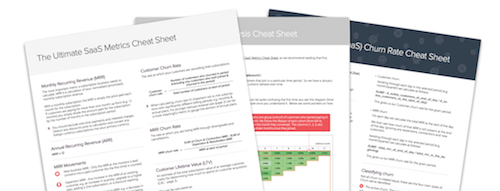Is negative churn a myth? You decide.
Lincoln Murphy defines negative churn as:
“When, for a given time period, expansion revenue more than offsets any revenue you lost from customer churn, downgrades, lower usage, etc.”
This happens when existing customers expand their use of your product by purchasing add-ons, paying more over time and increasing their Lifetime Value to such an extent that it makes up for any revenue lost to churn.
Here’s what that might look like:
Say you have a company that loses 5% to churn each month, but the 95% of remaining customers are so successful with the product that they purchase additional services, increasing spend by 10%. That makes the total revenue of one month equal 105% of the previous month’s revenue. Essentially, you have the same number of customers, but revenue continues to grow.
One article compares these ultra-valuable customer accounts to high-yield savings accounts where money keeps pouring in with minimal effort, but I don’t think that gives quite enough credit to how much achieving negative churn can transform businesses.
Expansion Served 3 Ways
Negative churn expansion typically comes in three flavors:
- Cross-Sell: Customers purchase add-ons that increase the abilities of the central product or service.
- Resource Expansion: Customers use more of the product, like upgrading a DropBox account to add more storage space.
- Seat Expansion: More customers within a company buy the product, and revenue increases by the number of people using it.
None of these three expansion methods happen by accident – usually, they are the results of efforts made by your customer success team. Rather than sales people focusing on bringing in new clients, the customer success team is able to focus solely on helping current clients achieve their goals, keeping them happy, satisfied, and eager for even greater successes.
It’s a well-established marketing fact that it’s easier to get more money from existing happy customers than it is to pry open the wallets of first-time customers. So why aren’t more companies focusing on continuing to win the hearts and dollars of their existing base? It’s a classic case of a bird in the hand being far better than two in the bush – yet we keep rustling those bushes!
Slow, Stop, Reverse: The Roadmap to Negative Churn
If negative churn were a place, like El Dorado – the City of Gold, its map would look like this: One road labeled “Customer Success” leading straight to it. No scenic route. No getting lost in the Amazon rainforest. Not even a dangerous river crossing with flesh-eating fish. Just a straightforward trip to the Promised Land that you could make in your mini-van. Seriously, it’s that simple. However, “easy” is another matter. Achieving negative churn takes time, perseverance, conviction, and commitment.
Do you have what it takes to…
- Ensure your customers achieve their desired outcome (hint: it’s a moving target!)?
- Be proactive in driving expansion revenue?
- Deliver value faster?
- Ask for the sale – and get the sale?
The definition of Customer Success is, literally, “ensuring your customers achieve their Desired Outcome through their interactions with your company.” Customers who don’t find success at first are not likely to expand their use of your product or service – but they’ll be more than happy to look for other solutions that aren’t yours. This is why you have to be proactive with customer success.
Have your customer success team track the lifespans of your customers and identify hints that all is not well – then make it well. Make it spectacularly well. Impress and delight those customers who are on the edge of leaving, and use lessons learned to help satisfied customers become even more successful.
“Delivering value faster not only makes for a very happy customer, but also speeds them on their way to taking advantage of your upsell opportunities.”
You’ll also use metrics to know when and how to drive expansion revenue. There will be a point in the lifecycle of your customers where upgrading, adding more seats, or purchasing add-ons is the next logical step. Identify that point for each customer segment, and when customers reach that point, deliver your upsell on a silver platter.
Some customers don’t stick around long enough for you to learn exactly why they’re unhappy – at least, that’s what you think. What often happens is that they’ve had a poor onboarding experience and it took too long for them to see value from your product or service. When onboarding is done right, it accelerates the time between when the client makes the purchase to when he or she sees the real value of what your company has to offer.
Delivering value faster not only makes for a very happy customer, but also speeds them on their way to taking advantage of your upsell opportunities. If that accelerated expansion revenue is tied to their success, then everybody wins.
Of course, the oldest adage in sales still applies: If you don’t ask for the sale, you won’t make the sale. It doesn’t matter if you’re working with brand new prospects or loyal customers. But, the trick to achieving negative churn is not only asking for the sale, but setting the stage to make that sale the next inevitable step. Maybe even as inevitable as the ebb and flow of the Atlantic – except for your business, it’s all flow.

Want to read more about SaaS Churn? Download The Ultimate Churn Rate Cheat Sheet PDF from ChartMogul.

